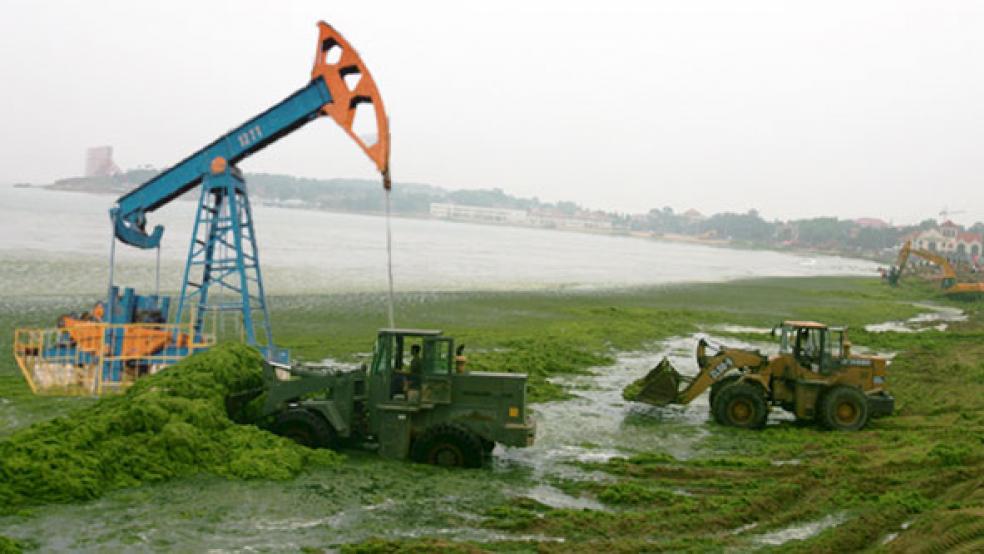This is the first in a series of columns that will report on 100 great ideas for innovation in America and around the world — how they are being funded and by whom, or whether the idea will pay off. This series comes as a debate rages in Washington and across the nation about whether the government or the private sector should fund the research and development of these ideas and turn them into economic growth engines. At the end of each column the idea will receive a letter grade for:
- Scientific or Technical Viability
- Commercial Viability
- Investment Requirements
- Launch Timetable
- Impact Benefits
Think of all the U.S. Navy ships trolling seven seas right now, from the shores of Tripoli to the pirate-infested waters off the horn of Africa: battleships, aircraft carriers, missile cruisers and submarines.
Now imagine those same ships fueled not by petroleum, but by algae.
The $10 Difference
While you’re pondering that possibility, also consider that every time the price of a barrel of oil goes up by $10 — as it has done in the past few days — it costs the U.S. Navy an additional $300 million to fuel the U.S. fleet. In the Navy’s fiscal 2012 budget just sent to Congress, they have asked for an additional $900 million to buy fuel based on an expected price rise to $131 a barrel.
Adding 10 bucks to the price of a barrel of oil reduces the growth of America’s GDP by half a percentage point within two years. And according to economist James Hamilton, a professor at UC San Diego, an increase of “$10 more per barrel for crude will leave consumers with about $35 billion less to spend each year on other items, consistent with a decline in consumption spending on the order of 0.2 percent of GDP in a $15 trillion economy.”
The federal government has reacted by pumping as much as $2 billion into R&D for plant-based fuels like algae since 2008 — not including subsidies and loan guarantees for ethanol — with most of these funds coming from the Department of Defense and the Department of Energy.
Biofuel plants on the fed’s R&D list include corn, switch grass and sugar cane, although none of these churn out oil like algae. In some algal species, half the volume of each little green cell is oil. By the barrel, algae also provides three to four units of energy for every one unit used to make it, a ratio that approaches petroleum’s golden 5-to-1 level of efficiency.
Corn, which is used to make ethanol, has a ratio of only 1.2 to 1, while cellulosic plants like switch grass have a 2.5 to 1 ratio (this ratio is being improved with bioengineered varieties of plants). Algae also can be refined and shipped in existing factories and pipes, and can be burned by current engines in cars, planes and naval destroyers.
So far, the 30 or 40 mostly small companies now developing algae fuels in the U.S. have produced thousands of barrels of green crude, a far cry from the 7 billion barrels of oil consumed each year in America. Producers also face the daunting task of scaling from demonstration projects to what amounts to a vast new infrastructure for growing and maintaining algae in either fermentation tanks or in open ponds, and in providing feedstock for the plants, which grow best when fed sugars and other carbons in the form of plant waste or CO-2.
Green crude from algae is not a new idea. The federal government first started researching algae and other plants as alternative fuels at the National Renewable Energy Laboratory (NREL) in Golden, Colorado, after the first oil shocks in the 1970s. The program, however, was shut down in 1996 when oil dropped down below $40 a barrel.
The feds got interested again during the sudden spike in oil prices in 2008, when the price per barrel hit $147. President Obama devoted $800 million of stimulus funds to R&D for algae and other biofuels, on top of hundreds of millions more spent by the armed services.
Private investors also have provided funding to companies such as San Diego-based Sapphire Energy, which has raised over $100 million from Bill Gates and other investors, plus $100 million in government loan guarantees and grants. Another San Diego Company, Synthetic Genomics, has been promised up to $600 million in funding over the next few years from ExxonMobil to develop bioengineered varieties of algae and other plants — one of several investments in algae made by Big Oil. Dow Chemical, Unilever and other large companies are also dipping a toe into algae.
San Francisco-based Solazyme is gearing up to produce hundreds of thousands of gallons of algae fuel using a fermentation process similar to making beer. The company is on track to deliver 150,000 gallons of ship fuel to the U.S. Navy this year. Solazyme and other companies are also introducing algae-based cooking oil, supplements and cosmetics.
All told, the public and private sectors combined have pumped as much as $3 billion into biofuel R&D since 2008, including algae — an amount that sounds impressive, though substantially more will be required if algae and other biofuels are ever to make a dent in the $540 billion spent last year by Americans for oil.
Tim Zenk, Sapphire’s vice president of public affairs, says that a barrel of Sapphire’s green crude right now costs about $400 to produce. “I expect this to be about $85 a barrel in about five years, when we scale up,” he says.
Unless more money is spent to scale up production, algae may not be replacing oil anytime soon. Yet as Kristina Burow of Arch Ventures, one of the investors in Sapphire, told me in 2009, they are aiming to hit 1 billion gallons of production by the 2020s. “We want to build an oil company,” she said. “This is not just a short-term play.”
Investability Report Card: Algae Fuels
These grades are based on the current state of the innovation, with an A awarded for ideas that are ready both technically and commercially to make a significant economic impact, and are adequately funded. A’s will be hard to get, but that doesn’t mean that the investment isn’t justified. Awarding a B means the innovation is close to ready; and so forth.
Scientific or Technical Viability: B+
Scientists developed the basics of algae fuel production in the 1970s. Green Crude faces an enormous challenge to scale the production of oil but can use existing factories to refine the oil into gasoline, jet fuel and diesel. Algae fuel also powers existing engines and generators with little or no modification. Its ratio of ‘energy needed to produce’ versus the energy it produces is impressive compared to other plant-based fuels. And scientists are improving the process through bioengineering and modern engineering technologies.
Algae fuel also has several methods being tested for viability, including fermentation and open-pond. One cautionary note is whether the products of green crude will create unexpected issues with pollution, and whether it is really cleaner to burn and produces less CO-2, than petroleum, as algae enthusiasts claim.
Commercial Viability: C+
Given the voracious appetite of Americans for liquid fuel — some 18.6 million barrels of oil a day — it is unlikely that an entirely new system based on a new crop can be scaled up quickly. With green crude from algae still costing hundreds of dollars a barrel to produce, and operations still small scale, algae oil is not yet commercially viable, and won’t be for perhaps a decade or more.
Investment Funding: C
Shutting down the first round of algae R&D programs at the Department of Energy in the 1996 was short sighted. Since the oil spike in 2008, the government and some oil companies have contributed hundreds of millions of dollars to researching the best approaches to producing algae fuels, including the latest bioengineering techniques designed to increase output and the ease of growing and harvesting this crop. This funding remains much too modest to test the idea to see if it can compete commercially with oil. Most likely, the government will provide limited funding for a scaling process, as Republicans and Democrats square off to cut the federal budget.
One question is whether Big Oil will invest more in algae. Chevron, Exxon Mobil and BP, among other large petroleum companies, have collectively invested hundreds of millions of dollars in green crude — a tiny sum given the size of these behemoths, though the interest of these companies to keep supplies of oil coming no matter what the source suggests more investment might be available in the future.
Impact and Benefits: B
The impact of algae fuels is years away from delivering a return on investments. However, when and if algae production scales, its impact could be substantial if it replaces even 10 to 20 percent of fossil fuels. The U.S. Navy wants biofuels to create a 10-ship “Green Strike Force” powered by biofuels by 2016; it also has pledged to replace 50 percent of its current fossil fuel use with alternative fuels by 2020 — a goal questioned by some critics as overly ambitious.
A recent report by Pike Research predicts that algae will reach a market value of $1.3 billion by 2020, but that sales will be 61 million gallons. Algae industry publications and companies dispute this, claiming the totals will be much larger.
Overall Grade: B-
How to get an A:
Current efforts will need to overcome technical issues in order to efficiently and cheaply grow and produce algae oil that can scale within five to 10 years. To achieve this the industry will need to attract significantly more investment from both the public and private sector. Government will need to aggressively use subsidies, loan guarantees, tax policy and other fiscal tools to encourage algae “farming” and production in the years before profits are possible. If algae oil can meet a timeline of supplying at least 1 billion gallons of liquid fuel needs by 2020, and 10 times that by 2030 – while achieving the promise of being a cleaner fuel than fossil fuels, then algae fuels will be deserving of an “A”.
Related Links:
Oil Prices Settle Higher as Gas Prices Jump (The Fiscal Times)
Who’s Winning the Clean Energy Race (The Fiscal Times)
The Terrible Implications of U.S. Oil Policy (The Fiscal Times)






